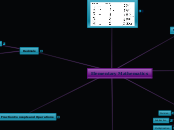Elementary Mathematics
Whole Number Operations
> AdditionModels:-Discrete: Characterized by the combining of two sets of discrete objects (individually separate, objects)-Continuous:Characterized by two continuous quantities (time, distance, etc.)Properties of Addition:-Closure: If you add any 2 whole numbers, the sum will be a whole number-Commutative: When adding, changing the order of the addend will result in the same sum-Associative: When adding 3 or more numbers, the grouping of the numbers will not change the sum-Identity: When adding 0 to any number, the sum will be the same number> SubtractionModels:-Take Away: Starting with an initial quantity and removing a specified amount-Missing Addend: The need to determine what quantity must be added to a specified quantity to reach a target amount-Comparison: Comparison of the relative sizes of two quantities to determine how much larger or smaller one of the quantitates is than the other quantity*No properties apply to Subtraction> MultiplicationModels:-Repeated Addition (discrete): Repeatedly adding a quantity of objects a specified number of times-Repeated Addition (continuous): Repeatedly adding a quantity over a specified time-Area Model: A product of two numbers representing the sides of a rectangular region such that the product represents the number of unit sized squares within that regionProperties of Multiplication:-Closure-Commutative-Associative-Identity: When you multiply a number by 1, the product will be the same number-Zero Property: When multiplying any number by 0, the product is 0> DivisionModels:-Partition (sharing): Distributing a given quantity among a specified number of partitions (groups) and determining the size of each partition (group)-Measurement (or required subtraction): Using a given quantity to create partitions of a specified size and determining the number of partitions (or groups) formed
aNumeration Systems
Hindu Arabic: (positional)ex: 1, 2, 3, 4, 5...Roman Numerals: (non-postional/ no bases)ex: i, ii, iii, iv, v * Quantity does not move upDecimal SystemTally
Bases

Digit:a symbol that will take up one and only one positionCounting Numbers (natural numbers):*does not include negativesex: 1, 2, 3...Base 10 (the one we use):0, 1, 2, 3, 4, 5, 6, 7, 8, 9, 10...*for bases > than 10 we need to insert symbolsBase 12:0, 1, 2, 3, 4, 5, 6, 7, 8, 9, X, E, 10, 11, 12, 13...*for bases < than 10 some digits do not existBase 2:0, 1, 10, 11, 100, 101, 110, 111, 1000, 1001, 1010...Base 5:0, 1, 2, 3, 4, 10, 11, 12, 13, 14, 20, 21, 22...*one hand, zero fingersex: 14 = one hand, four fingers
aAlgorithms of Whole Numbers
>Traditional algorithm*does not show/ include placement value425+ 176 --------- 601>Alternate algorithmspartial sums:425+ 176---------1190500---------601expanded notation:425+ 176---------400 + 20 + 5100 + 70 + 6 100 + 10 + 0 ------------------600 + 0 + 1 = 601left to right:425+ 176----------500 90+ 11----------601
Subtraction
> Traditional Algorithm732-387---------347> Expanded Notation734-387---------700 + 30 + 4-300 + 80 + 7------------------300 + 40 + 7 = 347> Left to right734-387-----------700 + 30 + 4-300 + 80 + 7-------------------400 + 50 + 7300 + 40 = 347
Multiplication
> Traditional 16x42--------32+640----------672> Strategiesdecomposing: 16x2-------3216x40-------640640 + 32 = 672area model: 6 x 2 = 12-------l l ll l ll l ll l ll l ll l l-------> Partial Product24x38--------600 (20x30)120 (4x30)160 (20x8)+ 32 ( 4 x 8 )------------------912
aDivision
Factors: numbers that are multiplied togetherTraditional: 134r14| 537-4-----13-12-------17-16-------1> Alternate algorithms*short division140r35| 703* do the subtracting and adding in head while writing the the new number above the next number to be brought downex: 5 can go into 7 one time so 7-5= 2. The 2 would then be written by the 0 in 703 and so on as the problem continues.*Partial quotient134r14| 537-400--------137-40-------97-80------17-16------1100x4= |400|10x4=|40|20x4=|80|+ 4x4=|16|-------------134r1
Integers and their Arithmetic
Integers: negative and positive numbers that include 0 but are not fractions or decimals. Zero Pair: when combined, the pair equals 0. when adding zero pairs, it keep the value of the problem the same since they = 0* p= positive and N=negative. Np=zero pair> Addition of Integers-4+7N pN pN pN p ppp=3> Subtraction of Integers1 - (-5)step 1: draw one positive chippstep 2: add 5 zero pairs because you cannot take 5 away from 1p N pN pN pN pN pstep 3: now take away the 5 negativespppppp= 6
Multiplication
> Multiplication of Integers3x4pppppppppppppppp pppp pppp-3x4nnnnnnnnnnnnpppppppppppp*remove 3 groups of positive 4nnnnnnnnnnnn= -12
Division
> Division of IntegersPartition model-12/4nnn nnn nnn nnnMeasurement (repeated subtraction)-12 / (-4)pppp pppp pppp
Fraction Concepts and Operations
Models:Area model, set model and linear4 Strategies for Comparing Fractions:1. Same size whole (denominator)2. Same number of parts (numerator)3. More or less than one4. closeness to 1/2 or 1Mixed Number: whole number and a fractionex: 1 3/4Applications of Fractions:Models for Addition and Subtraction:Discrete: objects (set model)Continuous: number line (linear)Take Away: set/area modelComparison: linear/area modelMissing Addend
Multiplication and Division
Multiplication:Use a Unit Square to multiply fractionsDivision:Use a ruler to divide fractions
Decimals
.1 = one tenth.14 = fourteen hundredths .783 = seven hundred eighty-three thousandthsBase Ten Representations:6.84 =|_| |_| |_| |_| |_| |_|||||||||. . . . Comparing Decimals3.4|_| |_| |_|||||3.21|_| |_| |_|||.3.4 > 3.21Expanded Form:34.26 =(3x10) + (4x1) + (2x.1) + (6x.01)Fractions to Decimals:1/2 = .5.52|1.0-10-------0
Addition and Subtraction
For Addition and Subtraction:Use the Base 10 Representation to show your work
Multiplication
For Multiplication:Use a Unit Square
